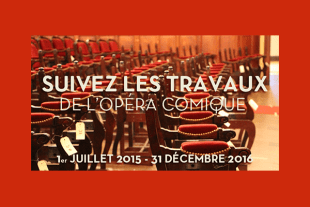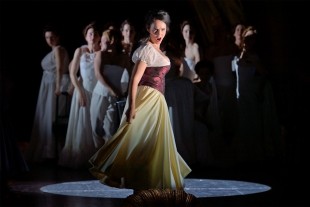In the theater things are tidied up and repacked. The ebb of tools used on the construction site is permanent now. Outside, the services of the Ministry of Culture and those of the Opéra Comique cooperate to announce the imminent reopening, and in late February the very first refurbishment of the technical equipment took place. The doors are expected to open by the end of March.
The theater slowly empties itself of scaffolding, plastic tarps and protections. The bulk of the work is coming to an end. The ventilation system is installed at last, the stage network is taking shape, the orchestra pit is completed and the connections for the returns are set. The technical teams are taking possession of the stage. The equipment stored in the basement at Rue du Sentier is gradually brought back and everything is being checked. Tests and controls are performed to ensure the proper functioning of the building. More than ever, safety comes first.
In spite of the dust and tarps, Favart slowly comes out of its hibernation. A spring air is being felt. The chandeliers and wall lights are back in the foyer and along the corridors and some 160 bulbs now adorn the cupola. The hangings dress the wall of the auditorium anew. The big cleaning remains to be done.
Yet something has changed. A detail that is invisible to newcomers but not to enthusiasts of our house: the crimson of the hangings and of the velvet – the famous “Favart red” – is different. Like many Italian-style theaters, the Opéra Comique is adorned with red. Except that the Salle Favart used to have a distinctive red. Used to, since until now its special kind of red had been lost. By sounding the ceilings, searching for ancient fabrics in the boxes, examining the paintings of the foyer and restoring the curtains, it became evident that the red employed was not the right one. This long scientific task enabled us to restore the subtle and delicate “Opéra Comique red” through the hangings of boxes and the velvet of guard rails.
Behind the curtain, the construction site is still alive. The offices, stairways and corridors are being repainted, the parquetries sanded. One of the best achievements is to be found in the costume workshop where a light shaft now brings light to the three levels of it. Steel, glass and wood blend in perfect harmony. Gustave Eiffel’s structure is revealed at last beneath the glass canopy. The marriage of the old and the new is a great success.
The promise of a new day is in the air. We’ll soon come back home. You’ll soon recover your opera house. It will be on the occasion of Alcione with the arrival of the artists for the rehearsals on April 2nd.






















